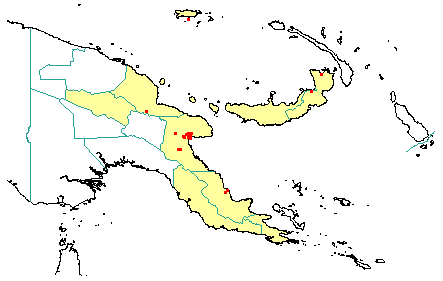
in PNGplants database
PNGTreesKey – Chisocheton cumingianus (C.DC.)Harms |
Barry Conn (NSW) & Kipiro Damas (LAE).
Guide to trees of Papua New Guinea
Copyright held by the authors, National Herbarium of New South Wales, and Papua New Guinea National Herbarium
in Engler & Prantl, Die Natürlichen Pflanzenfamilien Vol. 3 (4): 296 (1896)
Other Literature: D.J. Mabberley & A.M. Sing, Flora Malesiana, Series 1 164-166 (1995) Fig. 24.
Family: Meliaceae
Dicotyledon
Timber Group: Commercial hardwood
Field Characters: Large canopy tree (up to 37 m high); Bole markedly fluted (trunk may be flutted up to 10 m from base; trunk up to 150 cm diam.); crooked (bole up to 14 m long) or straight; buttresses buttresses present (buttresses up to 2 m high, rarely to 3 m); spines spines absent; aerial roots aerial roots absent; stilt roots stilt roots absent; Bark grey or slightly brown, rough, scaly or flaky or slightly pustular, lenticels rounded/swelling (scattered); Subrhytidome (under-bark) yellowish white; less than 25 mm thick, 10.0-12.0; bark blaze consisting of one layer; faintly to non-aromatic; outer blaze white or pale yellow, markings absent, fibrous; inner blaze white or pale yellow, markings absent, fibrous; bark exudate (sap) present, colourless, not readily flowing (spotty), colour not changing on exposure to air, not sticky; terminal buds not enclosed by leaves.
Indumentum: Complex hairs absent; stinging hairs absent; mature twig indumentum (hairs) absent.
Leaves: Leaves spaced along branches, spiral (leaves occurring singly at a node and arranged spirally up the branchlet), compound (a leaf made up from two or more leaflets); petiole present, not winged, attached to base of leaf blade, at base swollen; leaves pinnate (unbranched with more than three leaflets); petiolule not swollen; rachis present, absent; leaves with a terminal leaflet (the number of leaflets odd - imparipinnate), equally broad throughout much of length, (6.0-) 10.0-30.0 (-42.0) cm, (2.0-) 5.0-10.0 (-14.0) cm, leaflets opposite, symmetric, terminal developing leaflet buds curled back on itself; venation pinnate, secondary veins open, prominent, intramarginal veins absent; leaves lower surface pale green, upper surface green, indumentum (hairs) absent; absent; domatia absent; stipules absent.
Flowers: Inflorescence axillary (to supra-axillary), flowers on a branched axis, cones absent; flowers unisexual or bisexual, unisexual with male and female flowers on different plants, stalked, flowers with many planes of symmetry, 12.0-20.0 (-25.0) mm long, diameter small (up to10 mm diam.) (8-10 mm diam.); perianth present, with distinct sepals and petals whorls, inner perianth white or pale yellow; 3-5, some or partly joined; stamens 6-9, absent, joined (to form a staminal tube), free of the perianth; ovary superior, carpels joined (when more than one), locules 3-4; styles solitary, 1.
Fruits: Infrutescence arranged on branched axis, fruit 70.0-80.0 mm long, red or brown, not spiny, slightly fleshy, simple, indehiscent or slightly dehiscent, capsule; seeds 3-4, much more than 10 mm long (c. 50 mm long), not winged, narrow (longer than wide), seed more than 10 mm diam. (c. 30 mm diam.).
Distribution: Madang, Morobe, Western Highlands, Central, Northern, Milne Bay, New Britain & Manus.
 | Botanical records in PNGplants database |
Notes: Notes Although this species consists of two subspecies, only subsp. cumingianus occurs in Papua New Guinea.